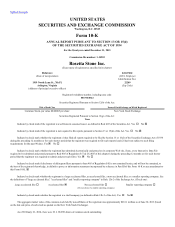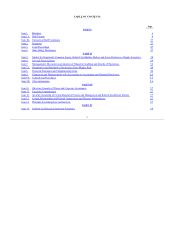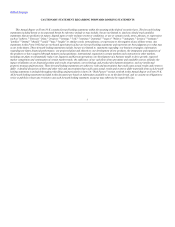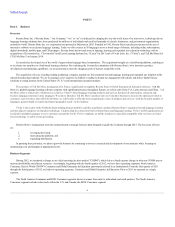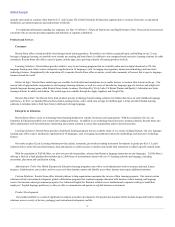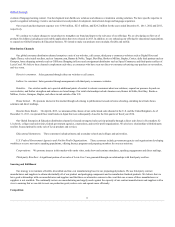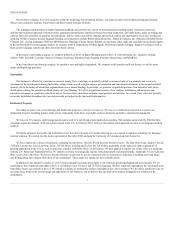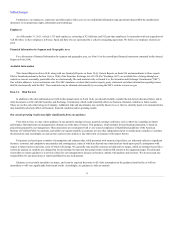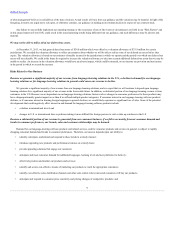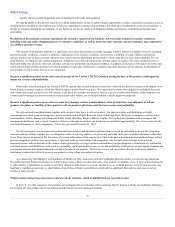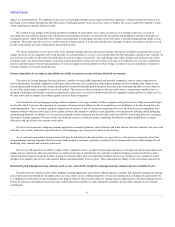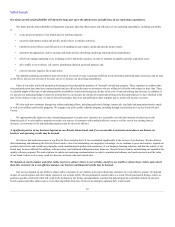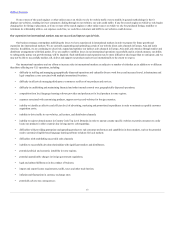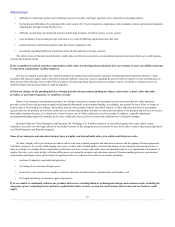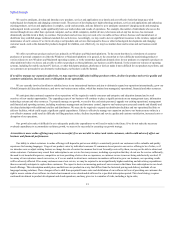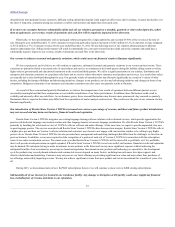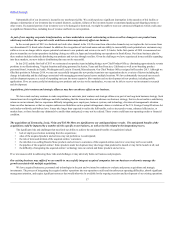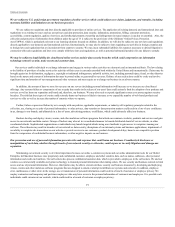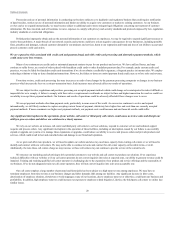Rosetta Stone 2013 Annual Report Download - page 11
Download and view the complete annual report
Please find page 11 of the 2013 Rosetta Stone annual report below. You can navigate through the pages in the report by either clicking on the pages listed below, or by using the keyword search tool below to find specific information within the annual report.
Table of Contents
•identify and successfully implement ways of building brand loyalty and reputation.
We may be unable to develop new solutions or solution enhancements in time to capture market opportunities or achieve sustainable acceptance in new or
existing markets. In addition, our solutions may become less appealing to consumers due to changes in technologies or reduced life cycles of our solutions. A
decline in consumer demand for our solutions, or any failure on our part to satisfy such changing consumer preferences, could harm our business and
profitability.
We depend on discretionary consumer spending in the consumer segment of our business. Adverse trends in general economic conditions,
including retail and online shopping patterns or consumer confidence, as well as numerous other external consumer dynamics may compromise
our ability to generate revenue.
The success of our business depends to a significant extent upon discretionary consumer spending, which is subject to a number of factors, including
general economic conditions, consumer confidence, employment levels, business conditions, interest rates, availability of credit, inflation and taxation.
Adverse trends in any of these economic indicators may cause consumer spending to decline further, which could hurt our sales and profitability. For our
retail business, we depend on the continued popularity of physical stores and malls to generate customer traffic for retailers. Decreases in physical store or
mall retail traffic may adversely affect our consumer sales and our profitability and financial condition. In addition, an increase in the taxation of online sales
could result in reduced online purchases or reduced margins on such sales. Furthermore, consumers may defer purchases of our solutions in anticipation of
new products or new versions from us or our competitors.
Because a significant portion of our sales come from sales of our Version 4 TOTALe product, pricing declines of this product could negatively
impact our revenue and profitability.
Historically, reduced pricing of our Version 4 product has resulted in increased unit sales volume in the direct-to-consumer web channel of our
North America consumer segment, which has offset the impact on sales from lower prices. We expect that the trend of lowering prices resulting in increased
unit volume and overall increased sales will continue in the direct-to-consumer web channel. However, given the scale of our business, if this trend does not
continue and lowering prices does not result in increased units sales volume, our overall profitability could be negatively impacted.
Because a significant portion of our sales are made to or through retailers and distributors, none of which have any obligation to sell our
products, the failure or inability of these parties to sell our products effectively could hurt our revenue and profitability.
We rely on retailers and distributors, together with our direct sales force, to sell our products. Our sales to retailers and distributors are highly
concentrated on a small group and comprises a mix of websites such as Digital River and Apple iTunes App Store, third party e-commerce websites, select
retail resellers, such as Amazon.com, Barnes & Noble, Target, Best Buy, Books-a-Million, Staples, Costco, daily deal partners such as Groupon and
consignment distributors such as Speed Commerce. Sales to or through our retailers and distributors accounted for approximately 18% of our revenue for the
year ended December 31, 2013, compared to 17% for the year ended December 31, 2012.
We have no control over the amount of products that these retailers and distributors purchase from us or sell on our behalf, we do not have long-term
contracts with any of them, and they have no obligation to offer or sell our products or to give us any particular shelf space or product placement within their
stores. Thus, there is no guarantee that this source of revenue will continue at the same level as it has in the past or that these retailers and distributors will not
promote competitors' products over our products or enter into exclusive relationships with competitors. Any material adverse change in the principal
commercial terms, material decrease in the volume of sales generated by our larger retailers or distributors or major disruption or termination of a relationship
with these retailers and distributors could result in a potentially significant decline in our revenue and profitability. Furthermore, product display locations and
promotional activities that retailers undertake can affect the sales of our products. The fact that we also sell our products directly could cause retailers or
distributors to reduce their efforts to promote our products or stop selling our products altogether.
As evidenced by the bankruptcy and liquidation of Borders in 2011, book stores and other traditional physical retailers are experiencing diminished
foot traffic and sales. Reduced customer foot traffic in these stores is likely to reduce their sales of our products. In addition, if one or more of these bookstores
or other retailers or distributors are unable to meet their obligations with respect to accounts payable to us, we could be forced to write off such accounts. Any
bankruptcy, liquidation, insolvency or other failure of any of these retailers or distributors could result in significant financial loss and cause us to lose
revenue in future periods.
Product returns and pricing concessions could exceed our estimates, which would diminish our reported revenue.
In the U.S., we offer consumers who purchase our packaged software and audio practice products directly from us a 30-day, unconditional, full money-
back refund. We also permit some of our retailers and distributors to return packaged products,
10

